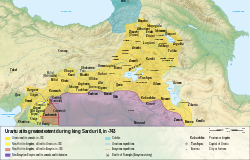History of Armenia
The history of Armenia and Armenians is very ancient and can go back at least 2000 BC. Archaeologists say the Shulaveri-Shomu culture of the central Transcaucasus region, and Armenia today, as the earliest known prehistoric culture in the area, carbon-dated to around 6000 - 4000 BC. But, a newer discovered tomb has been dated to 9000 BC. Another early culture in the Armenian Highlands and surrounding areas—the Kura-Araxes culture is in the period of ca. 4000 - 2200 BC, and is believed to have to go into the Trialeti culture (ca. 2200 - 1500 BC), and meaning Armenians are one of the oldest Indo-European subgroups.
Urartu
Urartu was an ancient kingdom in the Armenian Highlands.
Some experts say that the Armenians started as a mixture of the different peoples to move through the area in history: The Hurrians, Urarteans, Luvians and Mushki. This last group, also knowns as Phrygians may have brought their Indo-European language to Armenia. The Armenian language today is Indo-European, but shows a lot of influence from the earlier pre-Indo-European languages, especially Urartean. [1]
Ancient period
The Armenians had friendly relations with the Parthian empire.[2] The fighting between the Roman Empire and Parthia was centered in Armenia. Armenia was in between Parthian and the Roman Empire. The Armenians had already played a role in the early history of the Roman-Parthian relations. Tigranes put military and political relations with Rome and Parthia on an international legal foundation.[3] The Parthians were allies to Armenians in many times. Many Parthian noble families had moved out and they went to Armenia. In the year 301 AD, the Kingdom of Armenia adopted Christianity as its official state religion and Armenia went through a rapid period of Christianization and throughout the 4th century AD the whole of Armenia was Christianized and the Armenians all became Christian.[4][5]
History Of Armenia Media
Yerevan with Mount Ararat in the background
A 5500-year-old leather shoe—the oldest shoe in the world—was discovered in the Areni cave in Armenia. See Areni-1 shoe.
Bronze Age astronomical observatory Zorats Karer (also known as Karahunj).
The natural borders of the Armenian plateau and its peripheral regions according to H. F. B. Lynch (1901).
Related pages
References
- ↑ “Armenians” in Encyclopedia of Indo-European Culture or EIEC, edited by J. P. Mallory and Douglas Q. Adams, published in 1997 by Fitzroy Dearborn.
- ↑ The New Englander - Page 524 by William Lathrop Kingsley
- ↑ Armenian Perspectives - Page 282 by Nicholas Awde
- ↑ King of Kings by Gevork Nazaryan
- ↑ Aufstieg und Niedergang der römischen Welt Page 913 by Wolfgang Haase, Hildegard Temporini
Other websites
- Armenia at Livius.Org Archived 2007-10-01 at the Wayback Machine (ancient history)
- All about Armenia by www.haias.net Archived 2007-09-27 at the Wayback Machine
- Rulers.org — Armenia list of rulers for Armenia
- History of Armenia Archived 2007-09-27 at the Wayback Machine
- A book about the history of Armenia from 1827. It was written by a priest.







